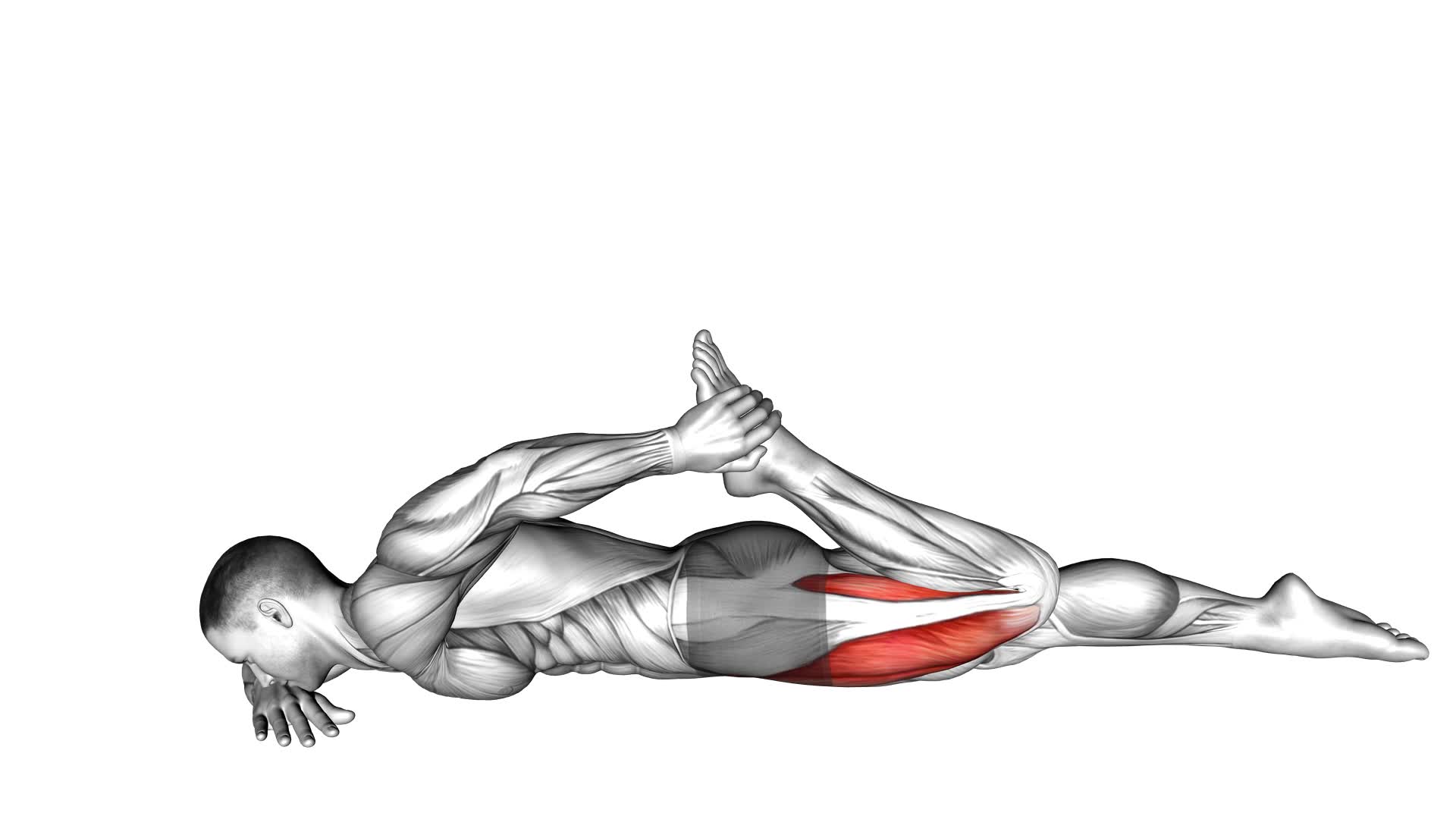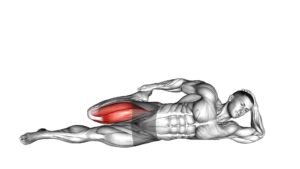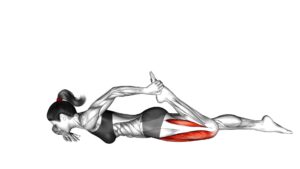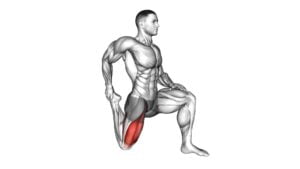Quadriceps Lying Stretch (Male) – Video Exercise Guide & Tips

Are you looking for an effective way to stretch your quadriceps muscles? Look no further than the Quadriceps Lying Stretch.
Watch This Exercise Video
This video exercise guide will show you how to properly perform the stretch, along with helpful tips to make the most out of your workout.
Whether you're a beginner or a seasoned fitness enthusiast, this stretch is suitable for all levels. Get ready to improve your flexibility and enhance your overall lower body strength.
Let's dive in and start stretching!
Key Takeaways
- The Quadriceps Lying Stretch targets the quadriceps muscles and increases flexibility and range of motion.
- It alleviates muscle tightness and reduces the risk of injury.
- Incorporating dynamic stretching exercises and activating the quadriceps muscles can enhance the effectiveness of the stretch.
- Experimenting with variations and modifications, such as using resistance bands or adjusting the angle of the leg, can further challenge the muscles and enhance flexibility.
Benefits of the Quadriceps Lying Stretch
You can experience several benefits from regularly performing the Quadriceps Lying Stretch. This stretching technique specifically targets the quadriceps muscles, which are located on the front of your thighs. By regularly stretching your quadriceps, you can increase flexibility and range of motion in this area. This can be particularly beneficial if you participate in activities that require kicking or jumping, such as soccer or basketball.
In addition to improving flexibility, the Quadriceps Lying Stretch can also help to alleviate muscle tightness and reduce the risk of injury. Tight quadriceps can lead to imbalances in your lower body, which can put strain on your knees and hips. By stretching these muscles, you can help to maintain proper alignment and reduce the risk of overuse injuries.
Furthermore, performing the Quadriceps Lying Stretch can also help to improve circulation in your legs. As you stretch the quadriceps, blood flow to the area increases, which can promote the delivery of oxygen and nutrients to the muscles. This can aid in muscle recovery and enhance overall performance.
Now that you understand the benefits of the Quadriceps Lying Stretch, let's move on to the next section and discuss how to properly prepare for this stretch.
Preparing for the Quadriceps Lying Stretch
To properly prepare for the Quadriceps Lying Stretch, begin by lying on your stomach with your legs straight. Before performing this stretch, it's important to warm up your muscles and prepare them for the exercise. Incorporating pre-stretch exercises into your warm-up routine can help prevent injuries and improve your overall flexibility.
Start your warm-up routine by performing some light cardiovascular exercises such as jogging or jumping jacks to increase blood flow and elevate your heart rate. This will help loosen up your muscles and prepare them for stretching.
Next, incorporate dynamic stretching exercises that specifically target the quadriceps muscles. Lunges and leg swings are great options to warm up and activate the quads. These exercises involve controlled movements that mimic the motions used during the Quadriceps Lying Stretch.
By including these pre-stretch exercises in your warm-up routine, you're effectively preparing your muscles for the Quadriceps Lying Stretch. This will enhance the effectiveness of the stretch and reduce the risk of strain or injury.
Now that you have properly prepared your muscles, let's move on to the step-by-step guide to the Quadriceps Lying Stretch.
Step-by-Step Guide to the Quadriceps Lying Stretch
To properly perform the Quadriceps Lying Stretch, it's important to emphasize proper form and technique. This will ensure that you're effectively targeting the quadriceps muscles and minimizing the risk of injury.
Additionally, exploring the benefits and variations of this stretch can help you tailor it to your specific fitness goals and abilities.
Proper Form and Technique
Achieving proper form and technique is essential for the Quadriceps Lying Stretch to maximize its effectiveness. To ensure you're performing the stretch correctly, follow these three guidelines:
- Position yourself lying on your side with your bottom leg bent for support.
- Grasp your top ankle and gently pull it towards your glutes, feeling a stretch in your quadriceps.
- Keep your pelvis neutral and avoid any twisting or excessive tension in your lower back.
By maintaining proper technique during the Quadriceps Lying Stretch, you can experience the full benefits of stretching.
This exercise helps improve flexibility in your quadriceps, reducing the risk of injury, enhancing athletic performance, and alleviating muscle tightness.
Now that you understand the importance of proper form, let's explore the various benefits and variations of this stretch.
Benefits and Variations
Now, let's delve into the benefits and variations of the Quadriceps Lying Stretch, so you can further enhance your flexibility and prevent injuries with this exercise.
The Quadriceps Lying Stretch offers a range of benefits, including increased flexibility and improved muscle balance. By stretching the quadriceps, you can help reduce muscle imbalances and improve your overall performance in daily activities and sports. Additionally, this stretch helps prevent injuries by increasing the range of motion in your hip and knee joints.
To take your Quadriceps Lying Stretch to the next level, you can try some advanced variations. These include using a resistance band to add extra tension or performing the stretch on an unstable surface like a balance board. These advanced quadriceps stretches can challenge your muscles and enhance your flexibility even further.
Common Mistakes to Avoid
Avoid these common mistakes when performing the Quadriceps Lying Stretch to maximize its effectiveness. To ensure that you're getting the most out of this stretch, be mindful of the following:
- Incorrect positioning: One common mistake isn't positioning your body correctly. Make sure you lie flat on your stomach with your legs straight and your feet flexed. This will ensure that you're targeting the quadriceps muscles properly.
- Lack of stability: Another mistake to avoid isn't maintaining stability throughout the stretch. Keep your core engaged and your hips pressed firmly into the ground. This will help prevent any unnecessary strain on your lower back.
- Overstretching: Lastly, be careful not to overstretch your quadriceps. While it's important to feel a gentle pull, pushing yourself too far can lead to injury. Listen to your body and only stretch to a comfortable point.
By avoiding these common mistakes and practicing correct form, you can enhance the effectiveness of the Quadriceps Lying Stretch. Remember to always warm up before stretching and consult with a fitness professional if you have any concerns or questions.
Happy stretching!
Tips for Maximizing the Effectiveness of the Stretch
To maximize the effectiveness of the quadriceps lying stretch, focus on your breathing techniques. Take slow, deep breaths and exhale fully as you stretch your muscles.
Additionally, ensure proper body alignment by keeping your back straight and shoulders relaxed throughout the stretch.
Lastly, make sure to hold the stretch for an adequate duration, aiming for at least 30 seconds on each side.
Breathing Techniques During Stretch
Maximize the effectiveness of your quadriceps lying stretch by incorporating proper breathing techniques. When performing this stretch, it's important to focus on your breath to enhance muscle activation and deepen the stretch. Here are three breathing techniques to help you get the most out of your quadriceps lying stretch:
- Diaphragmatic breathing: Breathe deeply into your diaphragm, allowing your belly to rise as you inhale. This type of breathing promotes relaxation and oxygenates your muscles.
- Exhale during the stretch: As you stretch your quadriceps, exhale slowly and fully. This helps release tension in the muscles and allows for a deeper stretch.
- Maintain a steady breath: Keep your breath steady and rhythmic throughout the stretch. This helps you stay focused and relaxed, maximizing the effectiveness of the stretch.
Proper Body Alignment
Maintain proper body alignment during the quadriceps lying stretch to optimize its effectiveness and prevent injury.
Proper body alignment is crucial for improving flexibility and preventing injuries during any stretch. To achieve proper alignment, lie flat on your stomach with your legs extended behind you. Keep your hips and pelvis in a neutral position, avoiding any excessive arching or sinking.
Engage your core muscles to support your spine and prevent strain. As you bend your knee to bring your foot towards your glutes, ensure that your thigh remains parallel to the ground and your knee points straight down. Avoid any twisting or rotating of the leg.
Duration of the Stretch
Make sure you hold the quadriceps lying stretch for an adequate amount of time to get the most out of the exercise. Maximizing flexibility and preventing injuries are two important factors to consider when determining the duration of the stretch.
Here are three tips to help you maximize the effectiveness of the stretch:
- Hold the stretch for at least 30 seconds: This allows enough time for the muscles to relax and lengthen, increasing flexibility.
- Gradually increase the duration: Start with shorter holds and gradually work your way up to longer stretches. This helps prevent injury by allowing your muscles to adapt and become more flexible over time.
- Listen to your body: Pay attention to any discomfort or pain during the stretch. If you experience any, stop immediately and consult a healthcare professional.
Variations and Modifications of the Quadriceps Lying Stretch
To modify the Quadriceps Lying Stretch, you can adjust the angle of your leg. This variation allows you to target different areas of your quadriceps and achieve a deeper stretch.
To perform this modified stretch, lie on your stomach with your legs extended. Bend one leg at the knee and bring your heel towards your glutes. You can use a yoga strap or towel to hold onto your foot for added support.
Start by adjusting the angle of your bent leg. You can experiment with different degrees of knee flexion to find the most comfortable and effective stretch for you. By modifying the angle, you can target specific areas of your quadriceps, such as the rectus femoris or vastus lateralis.
It's important to listen to your body and stop if you feel any pain or discomfort. No equipment is needed for this modification, but using a yoga strap or towel can provide additional support and stability.
Remember to breathe deeply and relax into the stretch for maximum benefits.
Frequently Asked Questions
How Long Should I Hold the Quadriceps Lying Stretch?
To properly engage in quadriceps stretching techniques, it's important to know how long to hold the stretch.
The duration of the quadriceps lying stretch can vary depending on your fitness level and flexibility. Generally, it's recommended to hold the stretch for about 30 seconds to 1 minute.
This allows for the muscles to relax and lengthen, improving flexibility and reducing the risk of injury.
Regular quadriceps stretching has many benefits, including increased range of motion and improved athletic performance.
Can the Quadriceps Lying Stretch Help With Knee Pain?
The quadriceps lying stretch can be beneficial in relieving knee pain. By stretching the quadriceps muscles, you can help alleviate tension and tightness that may contribute to knee discomfort.
However, it's important to note that the quadriceps lying stretch is just one exercise and may not be sufficient on its own for addressing knee pain.
Additionally, incorporating other quadriceps strengthening exercises and alternative stretches for knee pain can provide a more comprehensive approach to managing and preventing knee discomfort.
Is It Safe to Perform the Quadriceps Lying Stretch if I Have a Knee Injury?
If you have a knee injury, it's important to be cautious when performing the quadriceps lying stretch. It may not be safe for you in this case. Instead, consider modifying the stretch or trying alternative stretches that are more gentle on the knee.
It's always best to consult with a healthcare professional or a qualified fitness instructor who can provide guidance and recommendations specific to your injury.
Can the Quadriceps Lying Stretch Improve Flexibility in the Hips?
Improving hip mobility is a common goal for many individuals. One way to achieve this is by incorporating quadriceps stretching into your routine. This exercise can help increase flexibility in the hips, allowing for a greater range of motion.
By regularly performing the quadriceps lying stretch, you can experience the benefits of improved hip mobility, which can enhance athletic performance and overall functional movement.
Remember to always consult with a healthcare professional before starting any new exercise program.
Can the Quadriceps Lying Stretch Be Done Before or After a Workout?
Before or after a workout, it's important to incorporate pre and post workout stretches into your routine.
These stretches help to warm up and cool down your muscles, improving flexibility and reducing the risk of injury.
One effective stretch is the quadriceps lying stretch, which targets the front of your thighs.
Conclusion
In conclusion, the quadriceps lying stretch is a beneficial exercise for stretching and strengthening the quadriceps muscles. By following the step-by-step guide and avoiding common mistakes, you can maximize the effectiveness of this stretch.
Additionally, there are variations and modifications available to suit different fitness levels and needs. Incorporating the quadriceps lying stretch into your routine can contribute to improved flexibility and overall lower body strength.

Author
Years ago, the spark of my life’s passion ignited in my mind the moment I stepped into the local gym for the first time. The inaugural bead of perspiration, the initial endeavor, the very first surge of endorphins, and a sense of pride that washed over me post-workout marked the beginning of my deep-seated interest in strength sports, fitness, and sports nutrition. This very curiosity blossomed rapidly into a profound fascination, propelling me to earn a Master’s degree in Physical Education from the Academy of Physical Education in Krakow, followed by a Sports Manager diploma from the Jagiellonian University. My journey of growth led me to gain more specialized qualifications, such as being a certified personal trainer with a focus on sports dietetics, a lifeguard, and an instructor for wellness and corrective gymnastics. Theoretical knowledge paired seamlessly with practical experience, reinforcing my belief that the transformation of individuals under my guidance was also a reflection of my personal growth. This belief holds true even today. Each day, I strive to push the boundaries and explore new realms. These realms gently elevate me to greater heights. The unique combination of passion for my field and the continuous quest for growth fuels my drive to break new ground.







